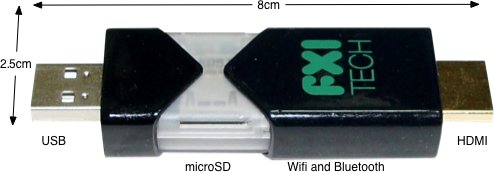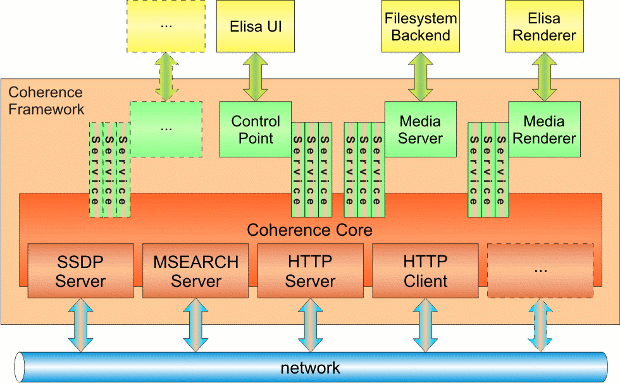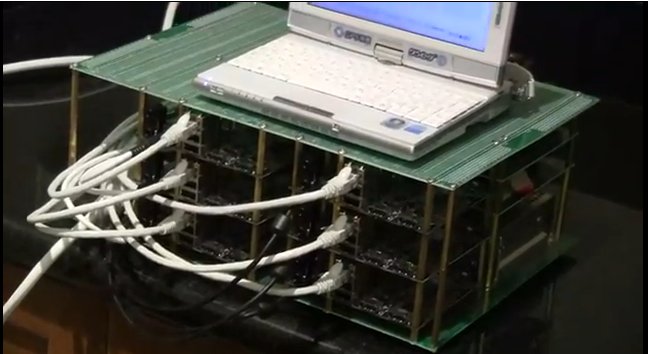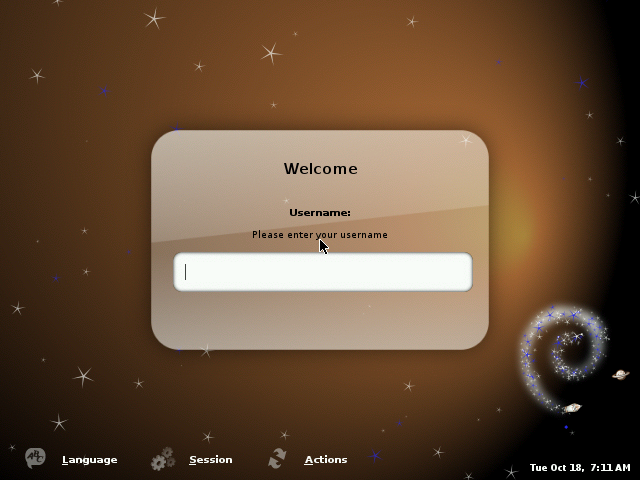FXI Technologies has unveiled a USB stick that turns any screen into an a computer running Android or Ubuntu, and in the future Windows 8 will also be supported. The Cotton Candy will include a Samsung Exynos 4210 dual-core ARM Cortex-A9 CPU clocked at 1.2GHz, with a Quad Core Mali 400MP GPU, like the Samsung Galaxy S2 smartphone. It will also feature 1GB of RAM, a microSD slot capable of holding up to 64GB of flash memory, Wifi and Bluetooth connectivity and an HDMI port. This small device (it measures 8cm x 2.5cm) has decent multimedia capabilities as it can support 1080p decode of MPEG4-SP/H.263/H.264 AVC/MPEG-2/VC1, as well as MP3, AAC, AAC+, Real Audio decoding and JPG, GIF, BMP, PNG pictures. Extra third party codec can also be added. There are 2 main use cases for the Cotton Candy: Connection to a HDMI-capable TV or Display: Connect an HDMI monitor/TV […]
DLNA/UPnP Linux Server with Coherence
Coherence is a DLNA/UPnP Media Server written in Python which exports local files or online media to UPnP clients. Coherence fetch the media files from several sources such as: Local applications media collections, like those from Rythmbox or Banschee, Audio-CD or DVB Online services like Flickr, last.fm, YouTube, Picasa Web Albums and other. Other sources can also be added thanks to Coherence plug-in architecture. The media server supports transcoding (currently experimental) that is to convert media files in another format. Coherence toolkit also contains other packages such as: Coherence-Config: a cross-platform GUI frontend for ‘Coherence’. Cadre: a picture DLNA/UPnP MediaRenderer which can display pictures from the local filesystem or from a MediaServer. Mirabeau: An application level proxy for UPnP devices which allows to share your UPnP content between two or more local networks over the Internet. It uses XMPP as a transport (work in progress). UPnP-Inspector: a graphical UPnP Device […]
Enable OpenGL 2.0 and WebGL for Intel GMA3150 in Ubuntu
I wanted to use WebGL in my Acer Aspire One D255E netbook that uses an Intel GMA 3150 onboard graphics card, but it did not work in Chromium nor Firefox. WebGL requires OpenGL 2.0 support, but I found out I only had support for OpenGL 1.4:
|
1 2 |
glxinfo | grep -i "OpenGL version" OpenGL version string: 1.4 Mesa 7.7.1 |
But I found out it was possible to enable OpenGL 2.0 for GMA 3150 in Linux by installing and running driconf:
|
1 2 |
sudo apt-get install driconf driconf |
and clicking on “Enable limited ARB_fragment_shader support on 915/945.” and “Enable stub ARB_occlusion_query support on 915/945.” options. They are not enabled by default because they do cause problems. After those two options were enabled, OpenGL 2.0 was enabled.
|
1 2 |
glxinfo | grep -i "OpenGL version" OpenGL version string: 2.0 Mesa 7.7.1 |
But I still could not use WebGL in either Chromium nor Firefox, so I decided to install the latest version of Mesa (7.11) with indirect rendering (software) enabled with libOSMesa:
|
1 2 3 4 5 6 7 |
sudo apt-get install libffi-dev wget ftp://ftp.freedesktop.org/pub/mesa/7.11/MesaLib-7.11.tar.bz2 tar xjvf MesaLib-7.11.tar.bz2 cd Mesa-7.11 ./configure --enable-os-mesa --prefix=/usr make make install |
Even with the latest Mesa library, I could not use WebGL […]
Ubuntu Linaro Evaluation Builds (LEB) Tutorial
Ricardo Salveti, tech lead of the Developer Platform working group, gave a tutorial on the Ubuntu Linaro Evaluation Builds (LEBs) during Linaro Connect Q4.11. He first described the list of available images: nano – minimal rootfs (command line) with apt/dkpg support ALIP – nano + X11 + browser Developer – nano + development tools Ubuntu Desktop – clone of Ubuntu with Linaro modifications. and how the builds are made available via nightly builds and hardware packs. Linaro aims at making Ubuntu the reference Linux distribution for ARM. This goal is valid for Cortex A processors, but for older ARM core (ARM9/ARM11) other distributions will have to used such as Debian. For example, Raspberry Pi board (ARM1176) will support Fedora optimized by Redhat. He then gave further details on Offspring the Linaro build system based on live-build scripts used for Debian. The source code is retrieved either via git (http:/git.linaro.org) or launchpad […]
Linaro 11.10 Release with Linux Kernel 3.1
Linaro has just released version 11.10 based on Linux Kernel 3.1. Here are the highlights of the release: Android Audio playback and recording works on LEB-panda. TJBench into all Android builds benchmarked against the original Android libjpeg implementation: TomGall/LibJpegTurbo All strict-aliasing violations in 2.3.5 have been fixed and sent to AOSP. (for build optimization) Linaro Gerrit is integrated with Android Build Service for change verification as part of Continuous Integration effort. Tip toolchain tracked and released against all targets for 11.10. iMX53 will now boot with a 3.0 or later Android Kernel. The multimedia test application has been extended to cover encoding and give better benchmark results. Linaro’s Android distribution can now base builds off a tip toolchain build. Linaro’s 11.09 toolchain has been benchmarked. USB camera (UVC) now works on linaro-android builds. Developer Platform The Linux Linaro packages are now generated and validated in a continuous integration loop. New […]
Pandaboard Cloud Cluster Running Google App Engine
Noritsuna Imamura showed an ARM cloud cluster built with 6 Pandaboards at Linaro Connect Q4.11. Noritsuna is a member of the Open Embedded Software Foundation (OESF), a Japanese organization that support Open Source embedded software. The cluster is made of 6 panda boards with a total 6 GB of RAM (1GB per board) that runs the Google App Engine (http://code.google.com/appengine/) in Ubuntu/Linaro 11.09 release. The middleware used is TyphoonAE, a full-featured and productive serving environment to run Google App Engine (Python) applications. This type of server hosts web applications such as Rietveld (used in the demo below) to be run on (thin) clients. There are also plenty of other software (required by Google App Engine) that runs in this ARM cloud such as MySQL, Apache2, memcached and more. In the video, a power meter shows that the cluster consumes about 35 W in low activity mode. Norisuna had a comparison […]
Ubuntu on Tegra 2 Netbook and Ubuntu Server on Pandaboard
Canonical showcases several demos at ARM Techcon 2011: Toshiba AC-100 Netbook (Nvidia Tegra 2) running Ubuntu 11.10. with Unity interface. Freescale i.MX53 board playing a 1080p video in Ubuntu 11.10. TI Pandaboard running Ubuntu 11.10 Server Edition. Ubuntu 11.04 is not officially supported for Toshiba AC-100, but the community if working on it and the image can be downloaded at http://ac100.gudinna.com/ Canonical however supports Netbook and Headless (Server) edition for OMAP3 (Beagleboard) and OMAP4 (Pandaboard). Those image are available at https://wiki.ubuntu.com/ARM/NattyReleaseNotes Watch the interview by Charbax and demos in the video below. Jean-Luc Aufranc (CNXSoft)Jean-Luc started CNX Software in 2010 as a part-time endeavor, before quitting his job as a software engineering manager, and starting to write daily news, and reviews full time later in 2011. www.cnx-software.com
Using Raspberry Pi as an Internet Kiosk
Following up on this morning post explaining how to get the kernel and minimal rootfs to run debian in qemu emulating an ARM1176 processor, I’ll show how to make a minimal rootfs to run Chrome browser in this platform. I tested it in QEMU, but this should also run on the Raspberry Pi hardware. First, you’ll have to complete the step I provided in Raspberry Pi Emulator in Ubuntu with Qemu. Start qemu: sudo qemu-system-arm -M versatilepb -cpu arm1176 -m 256 -hda rootfs.ext2 -kernel zImage -append “root=/dev/sda” -serial stdio Once you login to the console as root, create a new user (e.g guest): adduser guest This user will be needed to login with the graphical interface and ssh. In order to get an Internet Kiosk, we’ll need a web browser (Chromium) and a window manger. I chose fluxbox instead of gnome because of the size difference (8651 KB vs 1739 […]







